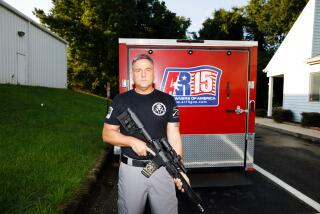Phasers on Stun
- Share via
They were made by Americans for Americans, and virtually anyone who was a child in this country during the era that spanned the Great Depression and the Vietnam War will have a memory of them: toy ray guns.
And, as often happens with items that become icons of popular culture, they were created to promote something: in this case, the star of a comic strip and radio show (and later television and movies) called Buck Rogers and his subsequent competition, Flash Gordon.
“Until the actual inauguration of the space race in the 1950s and early 1960s,” writes American art scholar Eugene W. Metcalf Jr., in “ray gun,” a book he has co-authored with New York art dealer Frank Maresca (Fotofolio; $19.95), “these two fictional characters were probably responsible for teaching most people what they knew about outer space.”
(To review: “Anthony ‘Buck’ Rogers was an air force officer who lapsed into a coma and awakened in the 25th century,” writes Metcalf, “where he found America in ruins and the world dominated by Mongolians from inland China.”)
In terms of consumer hysteria, Furbys and Tickle Me Elmos had nothing on the Buck Rogers XZ-31 Rocket Pistol, introduced in 1934. The day the guns went on sale at Macy’s, writes Metcalf, more than 2,000 people stood in line to buy the 49-cent toy. Gimbel’s then started a price war, offering the guns far below cost, at two for 19 cents. The
toymaker, Daisy Manufacturing Co. of Michigan, he writes, “exacerbated and profited by this situation by sending people into whichever store had the lowest price and buying backits guns, which were then sold to the other store.” Beat that for American ingenuity.
In “ray gun,” the toys are rendered in deliciously vibrant colors--deep blues, lush greens, fiery reds and oranges. Photographed by Charles Bechtold in hard focus, every detail, every crevice, button and lever feels as if it could be touched. Sometimes an old sci-fi movie poster appears--a vixenish Zsa Zsa Gabor, for instance, reclines across a lunar landscape for 1958’s “Queen of Outer Space”--but more often than not, the photos are of the imaginary weaponry itself.
The book “ray gun” is about children’s dreams of space and heroism in the years leading up to the moon landing. It’s about intergalactic fantasies, some of them lurid, and about dreaming of being Buck Rogers or Flash Gordon and zapping enemies into nothingness on a distant asteroid.
“The Atomic Water Pistol--Guaranteed to Atomise all Space Invaders,” says one bit of packaging.
“Ray gun” doesn’t glorify violence or guns. Instead, it is a paean to pulpy fantasies of sci-fi heroism--and, not coincidentally, a pop-culture history in miniature of how our notions of space, the final frontier, changed as we did.
*
The Associated Press contributed to this report. For information about ray guns, visit https://www.toyraygun.com.
More to Read
Sign up for our Book Club newsletter
Get the latest news, events and more from the Los Angeles Times Book Club, and help us get L.A. reading and talking.
You may occasionally receive promotional content from the Los Angeles Times.







